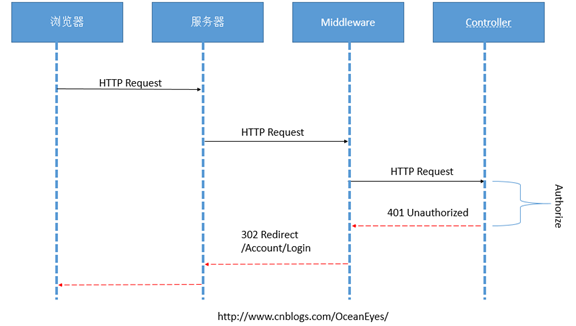https://www.cnblogs.com/OceanEyes/p/thinking-in-asp-net-mvc-apply-asp-net-identity-authentication.html
探索身份验证与授权
在这一小节中,我将阐述和证明ASP.NET 身份验证和授权的工作原理和运行机制,然后介绍怎样使用Katana Middleware 和 ASP.NET Identity 进行身份验证。
1. 理解ASP.NET 表单身份验证与授权机制
谈到身份验证,我们接触的最多的可能就是表单身份验证(Form-based Authentication)。为了更好的去理解ASP.NET 表单身份验证与授权机制,我搬出几年前的一张旧图,表示HttpApplication 19个事件,它们分别在HttpModule 中被注册,这又被称为ASP.NET 管道(Pipeline)事件。通俗的讲,当请求到达服务器时,ASP.NET 运行时会依次触发这些事件。

HttpApplication事件管道处理过程简单描述见 :https://www.cnblogs.com/wfy680/p/12331836.html
身份验证,验证的是用户提供的凭据(Credentials)。一旦验证通过,将产生唯一的Cookie标识并输出到浏览器,来自浏览器的下一次请求将包含此Cookie。
对于ASP.NET 应用程序,FormsAuthenticationModule注册HttpApplication 的管道(Pipeline)事件AuthenticateRequest ,当请求经过ASP.NET Pipeline时,由ASP.NET Runtime 触发它,在该事件中,它会验证并解析该Cookie为对应的用户对象,它是一个实现了 IPrincipal接口的对象;
PostAuthenticateRequest 事件在AuthenticateRequest 事件之后触发,表示用户身份已经检查完成 ,检查后的用户可以通过HttpContext的User属性获取并且HttpContext.User.Identity.IsAuthenticated属性为True。
如果将身份验证看作是"开门"的话,主人邀请你进屋,但这并不意味着你可以进入到卧室或者书房,可能你的活动场所仅限书房——这就是授权。在PostAuthenticateRequest事件触发过后,会触发AuthorizeRequest 事件,它在UrlAuthorizationModule 中被注册(题外插一句:UrlAuthorizationModule 以及上面提到的FormsAuthenticationModule你可以在IIS 级别的.config文件中找到,这也是ASP.NET 和 IIS紧耦合关系的体现)。在该事件中,请求的URL会依据web.config中的authorization 配置节点进行授权,如下所示授予Kim以及所有Role为Administrator的成员具有访问权限,并且拒绝John以及匿名用户访问。
<authorization> <allow users="Kim"/> <allow roles="Administrator"/> <deny users="John"/> <deny users="?"/> </authorization>
通过身份验证和授权,我们可以对应用程序敏感的区域进行受限访问,确保数据的安全性。
2.使用Katana进行身份验证
到目前为止,你可能已经对OWIN、Katana 、 Middleware 有了基本的了解,如果不清楚的话,请移步到此浏览。
使用Katana,你可以选择几种不同类型的身份验证方式,我们可以通过Nuget来安装如下类型的身份验证:
- 表单身份验证
- 社交身份验证(Twitter、Facebook、Google、Microsoft Account…)
- Windows Azure
- Active Directory
- OpenID
其中又以表单身份验证用的最为广泛,正如上面提到的那样,传统ASP.NET MVC 、Web Form 的表单身份验证实际由FormsAuthenticationModule 处理,而Katana重写了表单身份验证,所以有必要比较一下传统ASP.NET MVC & Web Form 下表单身份验证与OWIN下表单身份验证的区别:
|
Features |
ASP.NET MVC & Web Form Form Authentication |
OWIN Form Authentication |
|
Cookie Authentication |
√ |
√ |
|
Cookieless Authentication |
√ |
× |
|
Expiration |
√ |
√ |
|
Sliding Expiration |
√ |
√ |
|
Token Protection |
√ |
√ |
|
Claims Support |
× |
√ |
|
Unauthorized Redirection |
√ |
√ |
从上表对比可以看出,Katana几乎实现了传统表单身份验证所有的功能,那我们怎么去使用它呢?还是像传统那样在web.config中指定吗?
非也,Katana 完全抛弃了FormsAuthenticationModule,而是通过Middleware来实现身份验证。默认情况下,Middleware在HttpApplication的PreRequestHandlerExecute 事件触发时链式执行,当然我们也可以将它指定在特定的阶段执行,通过使用UseStageMarker方法,我们可以在AuthenticateRequest 阶段执行Middleware 进行身份验证。
那我们要怎样去实现呢?幸运的是,Katana已经帮助我们封装好了一个扩展方法,如下所示,
app.UseCookieAuthentication(new CookieAuthenticationOptions { AuthenticationType = DefaultAuthenticationTypes.ApplicationCookie, LoginPath = new PathString("/Account/Login") });
app.UseCookieAuthentication 是一个扩展方法,它的内部帮我们做了如下几件事:
- 使用app.Use(typeof(CookieAuthenticationMiddleware), app, options) 方法,将CookieAuthenticationMiddleware 中间件注册到OWIN Pipeline中
- 通过app.UseStageMarker(PipelineStage.Authenticate)方法,将前面添加的CookieAuthenticationMiddleware指定在 ASP.NET 集成管道(ASP.NET integrated pipeline)的AuthenticateRequest阶段执行
当调用(Invoke)此Middleware时,将调用CreateHandler方法返回CookieAuthenticationHandler对象,它包含 AuthenticateCoreAsync方法,在这个方法中,读取并且验证Cookie,然后通过AddUserIdentity方法创建ClaimsPrincipal对象并添加到Owin环境字典中,可以通过OwinContext对象Request.User可以获取当前用户。
这是一个典型Middleware中间件使用场景,说白了就是去处理Http请求并将数据存储到OWIN环境字典中进行传递。而CookieAuthenticationMiddleware所做的事其实和FormsAuthenticationModule做的事类似。
那我们怎么产生Cookie呢?使用ASP.NET Identity 进行身份验证,如果验证通过,产生Cookie并输出到客户端浏览器, 这样一个闭环就形成了,我将在下一小节实施这一步骤。
3.使用Authorize特性进行授权
ASP.NET Identity已经集成到了ASP.NET Framework中,在ASP.NET MVC 中,我们可以使用Authorize 特性进行授权,如下代码所示:
[Authorize]
public ActionResult Index()
{
return View();
}
上述代码中,Index Action 已被设置了受限访问,只有身份验证通过才能访问它,如果验证不通过,返回401.0 – Unauthorized,然后请求在EndRequest 阶段被 OWIN Authentication Middleware 处理,302 重定向到/Account/Login 登录

使用ASP.NET Identity 身份验证
有了对身份验证和授权机制基本了解后,那么现在就该使用ASP.NET Identity 进行身份验证了。
1. 实现身份验证所需的准备工作
当我们匿名访问授权资源时,会被Redirect 到 /Account/Login 时,此时的URL结构如下:
http://localhost:60533/Account/Login?ReturnUrl=%2Fhome%2Findex
因为需要登陆,所以可以将Login 设置为允许匿名登陆,只需要在Action的上面添加[AllowAnonymous] 特性标签,如下所示:
[AllowAnonymous]
public ActionResult Login(string returnUrl)
{
//如果登录用户已经Authenticated,提示请勿重复登录
if (HttpContext.User.Identity.IsAuthenticated)
{
return View("Error", new string[] {"您已经登录!"});
}
ViewBag.returnUrl = returnUrl;
return View();
}
注意,在这儿我将ReturnUrl 存储了起来,ReturnUrl 顾名思义,当登录成功后,重定向到最初的地址,这样提高了用户体验。
由于篇幅的限制,Login View 我不将代码贴出来了,事实上它也非常简单,包含如下内容:
- 用户名文本框
- 密码框
- 存储ReturnUrl的隐藏域
- @Html.AntiForgeryToken(),用来防止CSRF跨站请求伪造
2.添加用户并实现身份验证
当输入了凭据之后,POST Form 表单到/Account/Login 下,具体代码如下:
[HttpPost] [AllowAnonymous] [ValidateAntiForgeryToken] public async Task<ActionResult> Login(LoginModel model,string returnUrl) { if (ModelState.IsValid) { AppUser user = await UserManager.FindAsync(model.Name, model.Password); if (user==null) { ModelState.AddModelError("","无效的用户名或密码"); } else { var claimsIdentity = await UserManager.CreateIdentityAsync(user, DefaultAuthenticationTypes.ApplicationCookie); AuthManager.SignOut(); AuthManager.SignIn(new AuthenticationProperties {IsPersistent = false}, claimsIdentity); return Redirect(returnUrl); } } ViewBag.returnUrl = returnUrl; return View(model); }
上述代码中,首先使用 ASP.NET Identity 来验证用户凭据,这是通过 AppUserManager 对象的FindAsync 方法来实现,如果你不了解ASP.NET Identity 基本API ,请参考我这篇文章。
AppUser user = await UserManager.FindAsync(model.Name, model.Password);
FindAsync 方法接受两个参数,分别是用户名和密码,如果查找到,则返回AppUser 对象,否则返回NULL。
如果FindAsync 方法返回AppUser 对象,那么接下来就是创建Cookie 并输出到客户端浏览器,这样浏览器的下一次请求就会带着这个Cookie,当请求经过AuthenticateRequest 阶段时,读取并解析Cookie。也就是说Cookie 就是我们的令牌, Cookie如本人,我们不必再进行用户名和密码的验证了。
使用ASP.NET Identity 产生Cookie 其实很简单,就3行代码,如下所示:
var claimsIdentity =
await UserManager.CreateIdentityAsync(user, DefaultAuthenticationTypes.ApplicationCookie);
AuthManager.SignOut();
AuthManager.SignIn(new AuthenticationProperties {IsPersistent = false}, claimsIdentity);
对代码稍作分析,第一步创建了用来代表当前登录用户的ClaimsIdentity 对象,ClaimsIndentity 是 ASP.NET Identity 中的类,它实现了IIdentity 接口。
ClaimsIdentity 对象实际上由AppUserManager 对象的CreateIdentityAsync 方法创建,它需要接受一个AppUser 对象和身份验证类型,在这儿选择ApplicationCookie。
接下来,就是让已存在的Cookie 失效,并产生新Cookie。我预先定义了一个AuthManager 属性,它是IAuthenticationManager 类型的对象,用来做一些通用的身份验证操作。它 包含如下重要的操作:
- SignIn(options,identity) 故名思意登录,用来产生身份验证过后的Cookie
- SignOut() 故名思意登出,让已存在的Cookie 失效
SignIn 需要接受两个参数,AuthenticationProperties 对象和ClaimsIdentity 对象,AuthticationProperties 有众多属性,我在这儿只设置IsPersistent=true ,意味着Authentication Session 被持久化保存,当开启新Session 时,该用户不必重新验证了。
最后,重定向到ReturnUrl:
return Redirect(returnUrl);
使用角色进行授权
在前一小节中,使用了Authorize 特性对指定区域进行受限访问,只有被身份验证通过后才能继续访问。在这一小节将更细粒度进行授权操作,在ASP.NET MVC Framework 中,Authorize 往往结合User 或者 Role 属性进行更小粒度的授权操作,正如如下代码所示:
-
[Authorize(Roles = "Administrator")] public class RoleController : Controller { }
1.使用ASP.NET Identity 管理角色
对Authorize 有了基本的了解之后,将关注点转移到角色Role的管理上来。ASP.NET Identity 提供了一个名为RoleManager<T> 强类型基类用来访问和管理角色,其中T 实现了IRole 接口,IRole 接口包含了持久化Role 最基础的字段(Id和Name)。
Entity Framework 提供了名为IdentityRole 的类,它实现了IRole 接口,所以它不仅包含Id、Name属性,还增加了一个集合属性Users。IdentityRole重要的属性如下所示:
|
Id |
定义了Role 唯一的Id |
|
Name |
定义了Role的名称 |
|
Users |
返回隶属于Role的所有成员 |
我不想在应用程序中直接使用IdentityRole,因为我们还可能要去扩展其他字段,故定义一个名为AppRole的类,就像AppUser那样,它继承自IdentityRole:
public class AppRole:IdentityRole { public AppRole() : base() { } public AppRole(string name) : base(name) { } // 在此添加额外属性 }
同时,再定义一个AppRoleManager 类,如同AppUserManager 一样,它继承RoleManager<T>,提供了检索和持久化Role的基本方法:
public class AppRoleManager:RoleManager<AppRole> { public AppRoleManager(RoleStore<AppRole> store):base(store) { } public static AppRoleManager Create(IdentityFactoryOptions<AppRoleManager> options, IOwinContext context) { return new AppRoleManager(new RoleStore<AppRole>(context.Get<AppIdentityDbContext>())); } }
最后,别忘了在OWIN Startup类中初始化该实例,它将存储在OWIN上下文环境字典中,贯穿了每一次HTTP请求:
app.CreatePerOwinContext(AppIdentityDbContext.Create); app.CreatePerOwinContext<AppUserManager>(AppUserManager.Create); app.CreatePerOwinContext<AppRoleManager>(AppRoleManager.Create);
2.创建和删除角色
使用ASP.NET Identity 创建和删除角色很简单,通过从OWIN 上下文中获取到AppRoleManager,然后Create 或者 Delete,如下所示:
[HttpPost]
public async Task<ActionResult> Create(string name)
{
if (ModelState.IsValid)
{
IdentityResult result = await RoleManager.CreateAsync(new AppRole(name));
if (result.Succeeded)
{
return RedirectToAction("Index");
}
else
{
AddErrorsFromResult(result);
}
}
return View(name);
}
[HttpPost]
public async Task<ActionResult> Delete(string id)
{
AppRole role = await RoleManager.FindByIdAsync(id);
if (role != null)
{
IdentityResult result = await RoleManager.DeleteAsync(role);
if (result.Succeeded)
{
return RedirectToAction("Index");
}
else
{
return View("Error", result.Errors);
}
}
else
{
return View("Error", new string[] { "无法找到该Role" });
}
}
3.管理角色 MemberShip
要对用户授权,除了创建和删除角色之外,还需要对角色的MemberShip 进行管理,即通过Add /Remove 操作,可以向用户添加/删除角色。
为此,我添加了两个ViewModel,RoleEditModel和RoleModificationModel,分别代表编辑时展示字段和表单 Post时传递到后台的字段:
public class RoleEditModel { public AppRole Role { get; set; } public IEnumerable<AppUser> Members { get; set; } public IEnumerable<AppUser> NonMembers { get; set; } } public class RoleModificationModel { public string RoleName { get; set; } public string[] IDsToAdd { get; set; } public string[] IDsToDelete { get; set; } }
在对角色进行编辑时,获取所有隶属于Role的成员和非隶属于Role的成员:
/// <summary> /// 编辑操作,获取所有隶属于此Role的成员和非隶属于此Role的成员 /// </summary> /// <param name="id"></param> /// <returns></returns> public async Task<ActionResult> Edit(string id) { AppRole role = await RoleManager.FindByIdAsync(id); string[] memberIDs = role.Users.Select(x => x.UserId).ToArray(); IEnumerable<AppUser> members = UserManager.Users.Where(x => memberIDs.Any(y => y == x.Id)); IEnumerable<AppUser> nonMembers = UserManager.Users.Except(members); return View(new RoleEditModel() { Role = role, Members = members, NonMembers = nonMembers }); }
最终呈现的视图如下所示:

当点击保存,提交表单时,通过模型绑定,将数据Post 到Edit Action,实现了对角色的MemberShip 进行管理,即通过Add /Remove 操作,可以向用户添加/删除角色。
,如下所示:
[HttpPost] public async Task<ActionResult> Edit(RoleModificationModel model) { IdentityResult result; if (ModelState.IsValid) { foreach (string userId in model.IDsToAdd??new string[] {}) { result = await UserManager.AddToRoleAsync(userId, model.RoleName); if (!result.Succeeded) { return View("Error", result.Errors); } } foreach (var userId in model.IDsToDelete??new string[] {}) { result = await UserManager.RemoveFromRoleAsync(userId, model.RoleName); if (!result.Succeeded) { return View("Error", result.Errors); } } return RedirectToAction("Index"); } return View("Error",new string[] {"无法找到此角色"}); }
在上述代码中,你可能注意到了UserManager 类,它包含了若干与角色相关的操作方法:
|
AddToRoleAsync(string userId,string role) |
添加用户到指定的角色中 |
|
GetRolesAsync(string userId) |
获取User对应的角色列表 |
|
IsInRoleAsync(string userId,string role) |
判断用户是否隶属于指定的角色 |
|
RemoveFromRoleAsync(string userId,string role) |
将用户从指定角色中排除 |
初始化数据,Seeding 数据库
在上一小节中,通过Authorize 标签将Role 控制器受限访问,只有Role=Administrator的用户才能访问和操作。
[Authorize(Roles = "Administrator")] public class RoleController : Controller { }
但当我们的应用程序部署到新环境时,是没有具体的用户数据的,这就导致我们无法访问Role Controller。这是一个典型的 "鸡生蛋还是蛋生鸡"问题。
要解决这个问题,我们一般是在数据库中内置一个管理员角色,这也是我们熟知的超级管理员角色。通过Entity Framework Seed,我们可以轻松实现数据的初始化:
public class IdentityDbInit : DropCreateDatabaseIfModelChanges<AppIdentityDbContext> { protected override void Seed(AppIdentityDbContext context) { PerformInitialSetup(context); base.Seed(context); } public void PerformInitialSetup(AppIdentityDbContext context) { // 初始化 AppUserManager userMgr = new AppUserManager(new UserStore<AppUser>(context)); AppRoleManager roleMgr = new AppRoleManager(new RoleStore<AppRole>(context)); string roleName = "Administrators"; string userName = "Admin"; string password = "Password2015"; string email = "admin@jkxy.com"; if (!roleMgr.RoleExists(roleName)) { roleMgr.Create(new AppRole(roleName)); } AppUser user = userMgr.FindByName(userName); if (user == null) { userMgr.Create(new AppUser { UserName = userName, Email = email }, password); user = userMgr.FindByName(userName); } if (!userMgr.IsInRole(user.Id, roleName)) { userMgr.AddToRole(user.Id, roleName); } } }
在这儿实例化了AppUserManager和AppRoleManager实例,这是因为PerformInitialSetup 方法比OWIN 配置先执行。